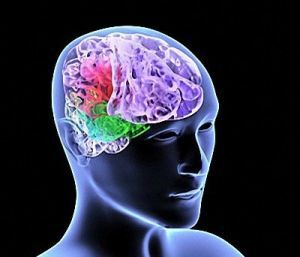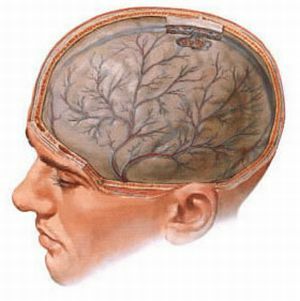 Discirculatory brain encephalopathy is a progressive vascular lesion, which is characterized by a gradual decrease in brain tissue supply.
Discirculatory brain encephalopathy is a progressive vascular lesion, which is characterized by a gradual decrease in brain tissue supply.
Brainflow of the brain is observed in approximately 6% of people, with most of these pathologies being chronic.
Consider the process of the development of the disease.
content
- types and stages of disease
- information about the first stage
- information about the second-stage
- What causes vascular encephalopathy brain
- Common signs and symptoms
- Diagnostic techniques
- Therapies
- Normalization pressure
- hypolipidemic treatment
- neuroprotective treatment
- Surgery
- Stenosis
- Prognosis
- Prevention of
- Disease Video: Dysirculatory encephalopathy
Species and stagesabdomen
Depending on the brightness of the manifestation of symptoms, the stages of this are isolated:
- I stage - moderately pronounced - a combination of symptoms is observed, which is called "cerebration".At this stage, there is a significant decrease in memory related to the present.
- II stage - pronounced - patients can not perform professional duties, there is an increase in personality changes, the criticism of patients to their condition is reduced.
- III stage - pronounced - at the same time several syndromes prevail, the emotional sphere suffers significantly. The sick are not professionally and socially adapted, they often lose the ability to self-service.
This deviation has several kinds that have certain characteristics.
Read more on the first stage of
 Circulatory encephalopathy - symptoms and treatment of 1st degree
Circulatory encephalopathy - symptoms and treatment of 1st degree Dyscirculatory encephalopathy of the 1st degree is a disease associated with poor functioning of the blood circulation of the brain, which in turn can lead to. ..
More information on the second stage
 Circulatory encephalopathy- symptoms and treatment of ECD of 2nd degree
Circulatory encephalopathy- symptoms and treatment of ECD of 2nd degree Discirculatory encephalopathy of the 2nd degree is a rather widespread neurological disease in our time, which can be. ..
Dicirculatory encephalopathy hypertensive type - is the result of repetitive hypertensive crises.
The atherosclerotic form of encephalopathy is manifested by pathological changes in the vessel wall that cause disorders of the blood flow of the brain and are a catalyst for atherothrombosis.
Venous encephalopathy is a separate type of this disorder, which occurs in diseases associated with impaired venous outflow from the brain.
Mixed encephalopathy has signs of all forms.
 Should I take the drug Tagesta - instructions for use, reviews of doctors and patients, indications and other necessary information in our material.
Should I take the drug Tagesta - instructions for use, reviews of doctors and patients, indications and other necessary information in our material.
There was a nuisance and you were bitten by a tick, - it does not matter. Learn how to treat borreliosis so that the disease does not end with sad consequences.
What causes discirculatory brain encephalopathy
The main causes that cause the development of this disease are atherosclerosis and high blood pressure.
There are also other causes of disease:
- high cholesterol;
- diabetes mellitus;
- heart disease;
- arthritis;
- smoking;
- excess weight;
- physical inactivity;
- alcoholism;
- constant stress;
- hereditary predisposition.
Common Symptoms and Signs
Each of the stages of the abnormality presupposes the presence of specific signs, but general symptoms of brain discirculatory encephalopathy that occur at all stages can be identified:
- headaches;

- dizziness;
- attention violations;
- cognitive impairment;
- reduced performance;
- impossibility of being in the company;
- depression;
- gait disturbance;
- gradual loss of autonomy.
If these symptoms appear, you should immediately contact a neurologist for diagnosis and examination.
The first stage of the disease manifests itself by such signs:
- hum in the head;
- headache;
- dizziness;
- sleep disturbance;
- memory reduction;
- imbalance in walking.
At the second stage have the place:
- attention violation;
- memory reduction;
- no control over their actions;
- pseudobulbar syndrome;
- irritability;
- depression.
The third stage of assumes:
- a pronounced violation of gait;
- urinary incontinence;
- Parkinsonism;
- impossibility of self-service;
- disinhibition;
- is dementia.
Diagnostic techniques
For diagnosis, the doctor must rely on the results of such methods studies:
- Reoencephalography is a study of the state of the vessels of the brain that gives information about their tone and the degree of filling with blood. The indices are obtained by means of a rheographic attachment, and the results appear as curves, which the doctor then deciphers.
- Computed tomography is a research method that helps to learn about the available atrophic processes in the brain. Based on the data obtained, you can determine the degree of brain damage.
- Evaluation of neurological signs of the disease - evaluation is performed by a neurologist with a visual examination of the patient, checking reflexes, based on complaints or from the words of relatives. Among the main neurological manifestations of this disorder are: increased tendon reflexes, impaired speech clarity, vestibular abnormalities, rigidity of muscles.
- Ultrasonic dopplerography - allows to detect thrombi in the vessels of the brain, to characterize the blood flow, its rate and the degree of its violation.
- Neuropsychological study - helps to identify the violation of mental functions: analysis and synthesis. The more advanced stage of encephalopathy the patient has, the more profound are the disturbances in the psyche.
- Blood test - with discirculatory encephalopathy, blood often has an increased viscosity, which causes the formation of thrombi and impairment of the blood circulation of the brain. Based on these studies, a picture of the disease is drawn up, its stage and algorithm of treatment is determined.
Treatment methods
 Treatment of discirculatory brain encephalopathy should be based not only on the results of the examination, but also on the analysis of the course of the disease.
Treatment of discirculatory brain encephalopathy should be based not only on the results of the examination, but also on the analysis of the course of the disease.
Discirculatory encephalopathy can appear as quickly, with multiple attacks, and slowly, stably.
There are many ways of treating the disease, but more often specialists use them in combination with to achieve better results.
Consider the main ones.
Pressure normalization
Hypertensive and mixed form of encephalopathy should be neutralized one of the main causes of its appearance - high blood pressure. To normalize the pressure of , such medications are used: clonidine, pentamine, octadine, phentolamine.
Lipid-lowering treatment
Measures aimed at neutralizing atherosclerosis.
It is atherosclerotic encephalopathy that is the most common type of disease, therefore, elimination of vascular problems is necessary in most cases.
As a hypolipidemic therapy, is prescribed: sermion, pentoxifylline, vinpocetine, piracetam.
Neuroprotective treatment
A method of treatment based on the effect of drugs on brain cells. At the same time, the quality of their work improves even with hypoxia due to impaired cerebral circulation: actovegin, cerebrolysin, gliatilin.
Surgical intervention
The operation is performed on the walls of the vessels, when only medication can no longer neutralize the existing vascular disease.
Stenosis
The procedure performed to restore the lumen of the artery. A sick atherosclerosis vessel is blocked by a plaque that blocks the flow of blood, so only stenosis of the carotid artery is a way out. 
Patients with this disorder should be constantly registered with a neurologist and follow medical appointments. Self-medication most often does not bring results, but only complicates the course of the disease and favors its acceleration.
Forecast
With the rapid development of the disease, the prognosis is less optimistic than slow.
Often, the in the first stage of the achieves significant improvements in the treatment of the disease and permanently suspends it, and in some cases is completely cured.
The second stage is less positive in this respect , but it gives an opportunity to achieve remission.
The most pessimistic forecast of in the third stage of is that the patient will not recover completely, his social skills and self-service skills almost disappear, and drug therapy is aimed mainly at eliminating manifestations.
To prevent the disease from developing to the most severe stages, it is necessary to take measures to treat it even when it is detected.
Prevention of the disease
Only by taking medications the effect can be achieved, but not for long. Fix the result and get rid of the consequences of encephalopathy for the score:
- of exercise therapy;
- of developing classes;
- permanent brain training;
- restrictions on products that cause a rise in pressure or the appearance of blood clots;
- blood cleansing products - citrus, broccoli, pomegranate, kiwi, bran, etc.;
- consumes large amounts of water.
Circulatory brain encephalopathy is the serious disease , which has extremely damaging consequences for human health. But the timely diagnosis and correct treatment many times increase the likelihood of complete disposal.
Therefore, when the first symptoms appear, you should immediately contact a competent doctor.
Video: Discirculatory encephalopathy
Educational lecture on discalcular encephalopathy. What you need to know about this disease?



